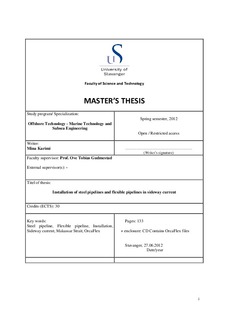| dc.contributor.author | Karimi, Mina | |
| dc.date.accessioned | 2012-10-16T12:16:32Z | |
| dc.date.available | 2012-10-16T12:16:32Z | |
| dc.date.issued | 2012 | |
| dc.identifier.uri | http://hdl.handle.net/11250/183002 | |
| dc.description | Master's thesis in Offshore technology | no_NO |
| dc.description.abstract | This master thesis is describing the theoretical & analytical principles of pipeline installation. In the literature survey stage we elaborate on basic information about different types of offshore pipelines. Installation also plays an important and vital role. Therefore in the next step we introduce various installation methods for offshore pipelines and what may govern the choice of an installation method / scenario. Then guidelines and constrains for establishing the different installation methods are matters of our concerns.
Calculations for two different cases related to documenting installation of steel pipelines and flexible pipelines in sideway current are included. The S-lay pipeline installation method will be taken for the analysis in the 2 case study of this thesis. Analysis will be carried out in 2 steps. First step is a static analysis and the second is a dynamic analysis. Fortunately the program OrcaFlex is capable to do both analyses.
The stinger elements are modeled as points which are held by links/tethers in both vertical and lateral directions. The links are restricted to only accept tension forces without any shear forces or bending moments. The idea is that these links will act as “roller” restraints.
Tension forces in a vertical link will represent stinger roller reactions when the pipe is sitting on the roller, and zero force will represent a pipe lift-off. Same criteria apply to the lateral links. Tension in a lateral link will represent a lateral reaction which is due to lateral forces on the pipe. These lateral links are simple but very useful components for the model to reach its equilibrium during iterations.
The upper end of the pipeline is fixed to the barge and will not accept torsion. This end represents the barge tensioner. The bottom end of the pipeline is pinned to the seabed with no torsion allowed and will represent an anchored end.
Different direction scenarios will be taken for the current. In this project the directions will be 0°, 30°, 60°, 90°, 120°, 150°, and 180°. Cases presented will be named based on these directions. OrcaFlex outputs will be observed to find out which scenario gives the “worst” condition during pipe-lay. | no_NO |
| dc.language.iso | eng | no_NO |
| dc.publisher | University of Stavanger, Norway | no_NO |
| dc.relation.ispartofseries | Masteroppgave/UIS-TN-IKM/2012; | |
| dc.subject | steel pipeline | no_NO |
| dc.subject | flexible pipeline | no_NO |
| dc.subject | sideway current | no_NO |
| dc.subject | Makassar Strait | no_NO |
| dc.subject | OrcaFlex | no_NO |
| dc.subject | offshore teknologi | no_NO |
| dc.subject | undervannsteknologi | no_NO |
| dc.title | Installation of steel pipelines and flexible pipelines in sideway current | no_NO |
| dc.type | Master thesis | no_NO |
| dc.subject.nsi | VDP::Technology: 500::Marine technology: 580::Offshore technology: 581 | no_NO |
